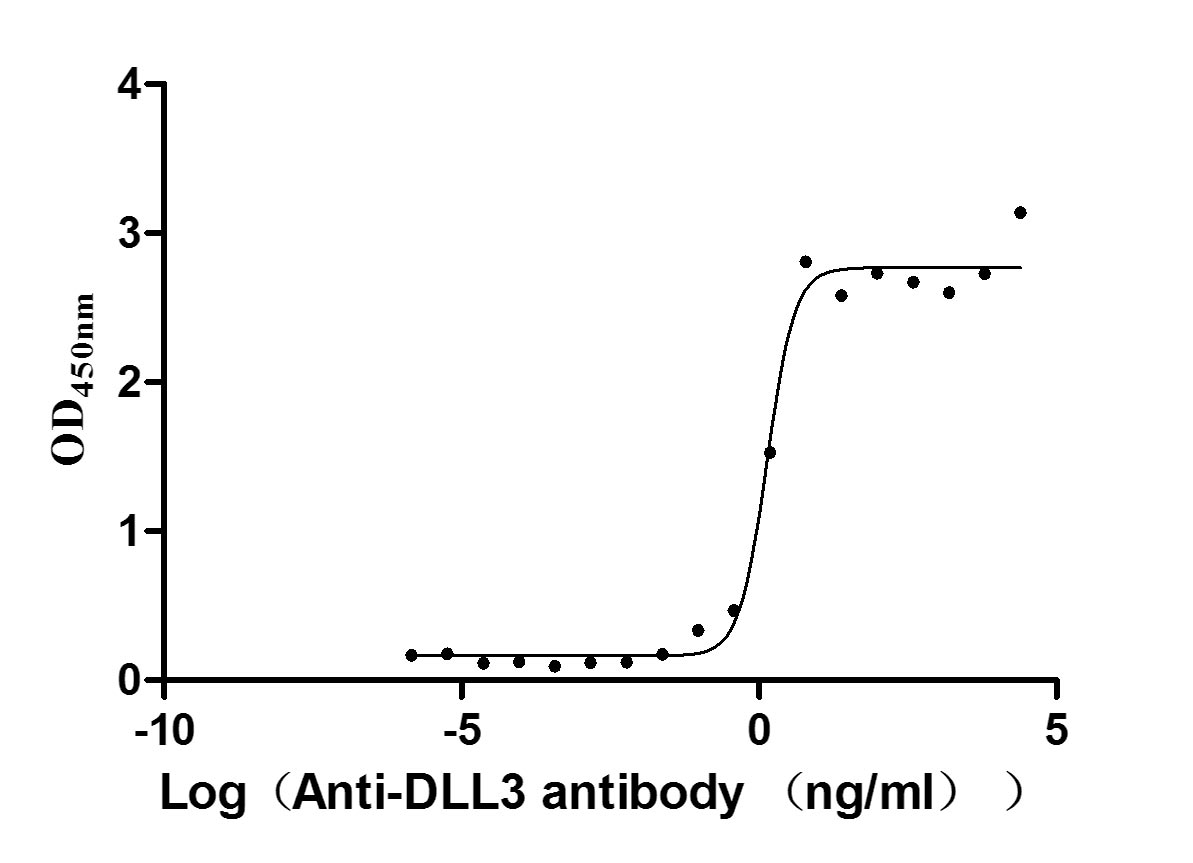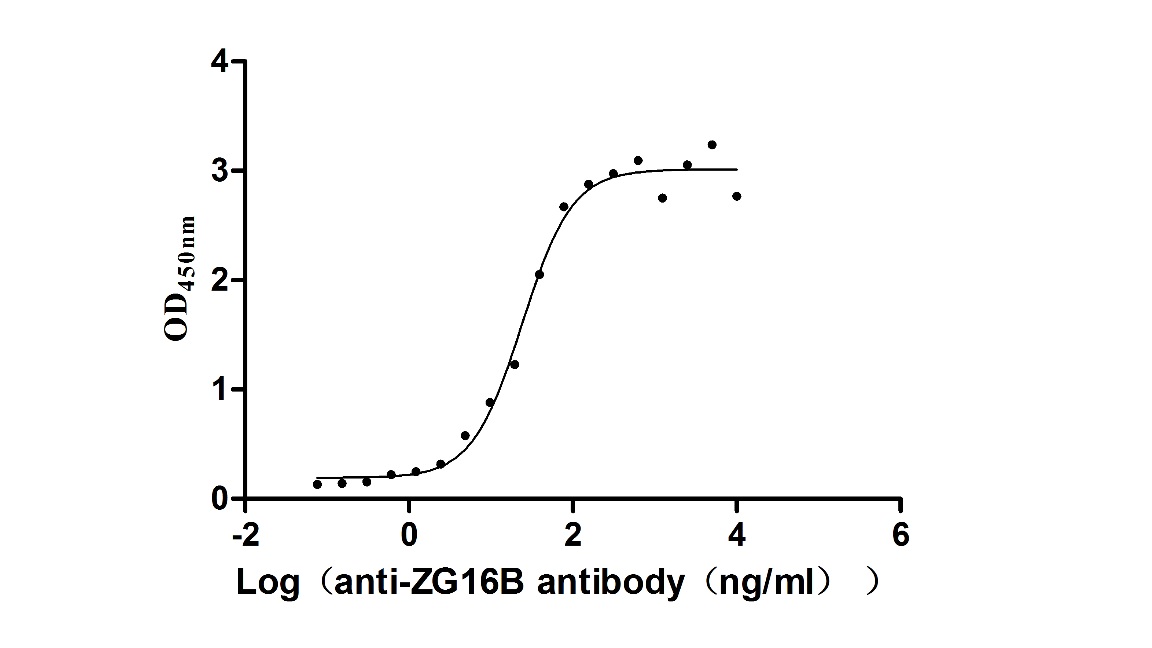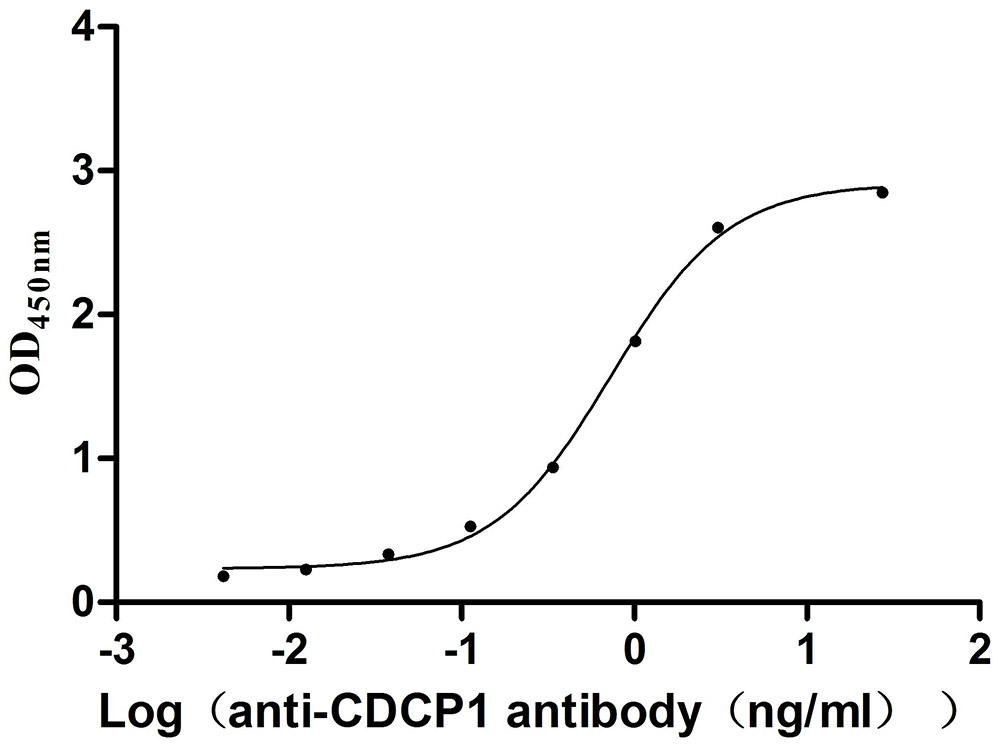Recombinant Mouse Krueppel-like factor 4 (Klf4)
-
货号:CSB-YP730657MO
-
规格:
-
来源:Yeast
-
其他:
-
货号:CSB-EP730657MO
-
规格:
-
来源:E.coli
-
其他:
-
货号:CSB-EP730657MO-B
-
规格:
-
来源:E.coli
-
共轭:Avi-tag Biotinylated
E. coli biotin ligase (BirA) is highly specific in covalently attaching biotin to the 15 amino acid AviTag peptide. This recombinant protein was biotinylated in vivo by AviTag-BirA technology, which method is BriA catalyzes amide linkage between the biotin and the specific lysine of the AviTag.
-
其他:
-
货号:CSB-BP730657MO
-
规格:
-
来源:Baculovirus
-
其他:
-
货号:CSB-MP730657MO
-
规格:
-
来源:Mammalian cell
-
其他:
产品详情
-
纯度:>85% (SDS-PAGE)
-
基因名:
-
Uniprot No.:
-
别名:Klf4; Ezf; Gklf; ZieKrueppel-like factor 4; Epithelial zinc finger protein EZF; Gut-enriched krueppel-like factor
-
种属:Mus musculus (Mouse)
-
蛋白长度:full length protein
-
表达区域:1-483
-
氨基酸序列MRQPPGESDM AVSDALLPSF STFASGPAGR EKTLRPAGAP TNRWREELSH MKRLPPLPGR PYDLAATVAT DLESGGAGAA CSSNNPALLA RRETEEFNDL LDLDFILSNS LTHQESVAAT VTTSASASSS SSPASSGPAS APSTCSFSYP IRAGGDPGVA ASNTGGGLLY SRESAPPPTA PFNLADINDV SPSGGFVAEL LRPELDPVYI PPQQPQPPGG GLMGKFVLKA SLTTPGSEYS SPSVISVSKG SPDGSHPVVV APYSGGPPRM CPKIKQEAVP SCTVSRSLEA HLSAGPQLSN GHRPNTHDFP LGRQLPTRTT PTLSPEELLN SRDCHPGLPL PPGFHPHPGP NYPPFLPDQM QSQVPSLHYQ ELMPPGSCLP EEPKPKRGRR SWPRKRTATH TCDYAGCGKT YTKSSHLKAH LRTHTGEKPY HCDWDGCGWK FARSDELTRH YRKHTGHRPF QCQKCDRAFS RSDHLALHMK RHF
-
蛋白标签:Tag type will be determined during the manufacturing process.
The tag type will be determined during production process. If you have specified tag type, please tell us and we will develop the specified tag preferentially. -
产品提供形式:Lyophilized powder
Note: We will preferentially ship the format that we have in stock, however, if you have any special requirement for the format, please remark your requirement when placing the order, we will prepare according to your demand. -
复溶:We recommend that this vial be briefly centrifuged prior to opening to bring the contents to the bottom. Please reconstitute protein in deionized sterile water to a concentration of 0.1-1.0 mg/mL.We recommend to add 5-50% of glycerol (final concentration) and aliquot for long-term storage at -20℃/-80℃. Our default final concentration of glycerol is 50%. Customers could use it as reference.
-
储存条件:Store at -20°C/-80°C upon receipt, aliquoting is necessary for mutiple use. Avoid repeated freeze-thaw cycles.
-
保质期:The shelf life is related to many factors, storage state, buffer ingredients, storage temperature and the stability of the protein itself.
Generally, the shelf life of liquid form is 6 months at -20°C/-80°C. The shelf life of lyophilized form is 12 months at -20°C/-80°C. -
货期:Delivery time may differ from different purchasing way or location, please kindly consult your local distributors for specific delivery time.Note: All of our proteins are default shipped with normal blue ice packs, if you request to ship with dry ice, please communicate with us in advance and extra fees will be charged.
-
注意事项:Repeated freezing and thawing is not recommended. Store working aliquots at 4°C for up to one week.
-
Datasheet :Please contact us to get it.
靶点详情
-
功能:Transcription factor; can act both as activator and as repressor. Binds the 5'-CACCC-3' core sequence. Binds to the promoter region of its own gene and can activate its own transcription. Regulates the expression of key transcription factors during embryonic development. Plays an important role in maintaining embryonic stem cells, and in preventing their differentiation. Required for establishing the barrier function of the skin and for postnatal maturation and maintenance of the ocular surface. Involved in the differentiation of epithelial cells and may also function in skeletal and kidney development. Contributes to the down-regulation of p53/TP53 transcription.
-
基因功能参考文献:
- Klf4 polyglutamylation plays a critical role in the regulation of cell reprogramming and pluripotency maintenance in a process that involves TTLL4 and TTLL1 PMID: 29593216
- KLF4 indirectly modulates the actin cytoskeleton morphology via activity of RhoA in order to inhibit cellular migration and invasion. PMID: 29498307
- Human and mouse WNT10A mutant palmoplantar and tongue epithelia also display specific differentiation defects that are mimicked by loss of the transcription factor KLF4. PMID: 28589954
- Mule-mediated ubiquitination of the novel substrate KLF4 regulates T-cell proliferation, autoimmunity and antiviral immune responses. PMID: 28084302
- miR-145 promotes hepatic stellate cell activation and liver fibrosis by targeting KLF4. PMID: 28091538
- miR-200b regulated adipocyte differentiation by directly targeting KLF4. PMID: 29864940
- The data highlight Klf4 as an essential MCPIP1-dependent modulator of innate immunity that protects against excessive and self-destructive inflammation. PMID: 29975947
- NF-kappaB signaling in SMCs plays an important role in high phosphate-induced arterial medial calcification in CKD. PMID: 29146611
- miR-145 protects follicular granulosa cell against oxidative stress-induced apoptosis by targeting KLF4. PMID: 28564582
- The results highlight a novel molecular mechanism underlying stability of neurogenesis-associated mRNAs controlled by the Klf4/Ddx5/Stau1 axis during mammalian corticogenesis. PMID: 29374155
- Analysis of tumor-infiltrating lymphocytes (TILs) demonstrated markedly increased activated CD8 T cell numbers, and CD8 T cell depletion obviated the inhibitory effect of myeloid Klf4 deletion on prostate cancer growth. PMID: 29324844
- Spermatogonial stem cells and progenitors are refractory to reprogramming to pluripotency by the transcription factors Oct3/4, c-Myc, Sox2 and Klf4. PMID: 28052023
- Based on these findings, we infer that MALAT1 is a transcriptional target of KLF4 in its protective role in cerebral MECs after ischemic insult. PMID: 29203245
- Folate receptor alpha upregulates Oct4, Sox2 and Klf4 and downregulates miR-138 and miR-let-7 in cranial neural crest cells. PMID: 27300003
- overexpression of KLF4 promoted oligomeric Abeta42-induced neuroinflammation by exacerbating the release of pro-inflammatory factors PMID: 28189744
- A long-range enhancer cluster controls Klf4 gene expression in mESCs PMID: 28982762
- we revealed that one of the key functions of KLF4-induced TCL1 during reprogramming is to promote the metabolic shift from oxidative phosphorylation to glycolysis. PMID: 28262547
- KLF4 modulates development of BMI1-expressing intestinal stem cell-derived lineage following gamma-radiation-induced gut injury in mice. PMID: 27237377
- dysregulation of Elovl6-driven long-chain fatty acid metabolism induces phenotypic switching of VSMC via ROS production and AMPK/KLF4 signaling that leads to growth arrest and downregulation of VSMC marker expression. PMID: 27881420
- Together, our results suggest that KLF4 regulates asthma development in a TSLP- and fibrocyte-dependent manner. PMID: 28867182
- Loss of KLF4 expression is associated with T-cell acute lymphoblastic leukemia. PMID: 27872496
- Functional studies indicated that Klf4 mediates the self-renewal-promoting effects of Gbx2, because knockdown of Klf4 expression abrogated the ability of Gbx2 to maintain the undifferentiated state of mESCs. PMID: 28848051
- Genetic inactivation of Klf4 in perivascular cells decreased formation of a pre-metastatic niche and metastasis. KLF4-dependent perivascular cell plasticity mediates pre-metastatic niche formation and metastasis. PMID: 28920957
- loss of KLF4 and expression of MUC2 could be important markers for gastric cancer diagnosis. PMID: 27277677
- During Mycobacterium tuberculosis infection, downregulation of miR-26a facilitates upregulation of KLF4. PMID: 28558034
- Data show that expression of the Oct-4, Sox2, Klf4, and c-Myc (OSKM) reprogramming factors induces Cyclin D1 expression, and the increased Cyclin D1 expression during reprogramming promotes continuing embryonic fibroblasts (MEFs) proliferation. PMID: 27790870
- endogenous KLF4 and Krox20 are dispensable for adipogenesis in culture and for brown adipose tissue development in mice. In contrast, the master adipogenic transcription factor peroxisome proliferator-activated receptor gamma (PPARgamma) is essential. PMID: 27777310
- Kruppel-like factor 4 was found to be a target gene of miR-10b in the enhancement of spermatogonial stem cell proliferation PMID: 28436141
- The role of Glu446 in Klf4 preference for DNA methylation PMID: 27596594
- Induction of the transcription factor Klf4 in differentiated smooth muscle cells is essential for smooth muscle cell reprogramming. PMID: 27834190
- KLF4 expression is negatively correlated to the Notch pathway in hepatic stellate cells. PMID: 27924515
- Data show that the reprogramming factors OCT4, SOX2, KLF4, and MYC (OSKM) drive cells along two distinct and parallel pathways, one pluripotent and one endodermal. PMID: 26947975
- Study demonstrates that KLF4 plays a significant role in the pathogenesis of colorectal neoplasia. PMID: 26839262
- our study provides valuable information on the molecular interactions between OSKM(Oct4, Sox2, Klf4, and Myc) and cofactors and molecular mechanisms for the functional importance of Set1a in ESCs and early development PMID: 26785054
- Data show that R-Smad Proteins SMAD1 and SMAD5, which transduce bone morphogenetic protein (BMP) signals, recognize enhancer regions together with Kruppel-like factors KLF4 and KLF5 in naive embryonic stem cell (mESCs). PMID: 26771354
- Results suggest that Kruppel-like factor 4 is not required for retinal cell differentiation or survival. Data support a hypothesis that KLF4 suppresses axon growth during development. PMID: 27022622
- KLF4 is a master regulator of EndMT in CCM pathology; thus, the inhibition of Klf4 expression may have a therapeutic role in limiting CCM appearance and progression. PMID: 26612856
- s show that absence of Klf4 accelerates carcinogenesis and correlates with the absence of cytokeratin 1 expression. Results suggest a potential role for KLF4 as a tumor suppressor gene for the tongue epithelium. PMID: 25605610
- KLF-4 was downregulated in the TGF-beta-induced EMT model in LA-4 cells. KLF-4 overexpression markedly reduced the PAI-1 expression and inhibited the TGF-beta-induced EMT . PMID: 26839446
- Data show that CCAAT-enhancer-binding protein-alpha (C/EBPalpha) directly regulates Kruppel-like factor 4 (Klf4) expression and increasing the levels of histone demethylase Lsd1 and transcription factor Brd4 in B cell. PMID: 26974661
- Angiotensin II can modulate epigenetic regulation in podocytes and renin-angiotensin blockade inhibits these actions in part via KLF4 in proteinuric kidney diseases. PMID: 26108068
- Data indicate that miR-25 is a novel negative regulator of adipocyte differentiation and it suppressed 3T3-L1 adipogenesis by targeting KLF4 and C/EBPalpha, which provides novel insights into the molecular mechanism of miRNA-mediated cellular differentiation. PMID: 25923408
- transcriptional cooperation between GR and Klf4 may determine cell-type specific gene expression regulation PMID: 26001834
- unravels a novel mechanism how matrix stiffness regulates cellular proliferation and highlights the importance of matrix stiffness-modulated Klf5/Klf4 in the regulation of renal physiologic functions and fibrosis progression PMID: 26212907
- positively regulates Pax6 expression and proliferation of neuronal progenitors in the rhombic lip, external granular layer and neuroepithelium PMID: 26226504
- The role of KLF4 on autophagy in mouse embryonic fibroblasts, was investigated. PMID: 25944097
- The hypermethylation of KLF4 directly mediated by Dnmt1 contributes to the progression of EMT in renal epithelial cells. PMID: 25892014
- these findings identify KLF4 as a nodal transcriptional regulator of mitochondrial homeostasis. PMID: 26241060
- KLF4 mediates the link between TGF-beta1-induced gene transcription activation and H3 acetylation during VSMC differentiation. PMID: 26082460
- Increased oxidative DNA Damage in mouse embryonic fibroblasts deficient for Klf4 is observed. PMID: 24788960
显示更多
收起更多
-
亚细胞定位:Nucleus.
-
蛋白家族:Krueppel C2H2-type zinc-finger protein family
-
组织特异性:Highest expression in the colon. Lower levels in testis, lung and small intestine.
-
数据库链接:
KEGG: mmu:16600
STRING: 10090.ENSMUSP00000103245
UniGene: Mm.4325
Most popular with customers
-
Recombinant Human Tumor necrosis factor receptor superfamily member 5 (CD40), partial (Active)
Express system: Mammalian cell
Species: Homo sapiens (Human)
-
Recombinant Human Delta-like protein 3 (DLL3), partial (Active)
Express system: Mammalian cell
Species: Homo sapiens (Human)
-
Recombinant Human B-lymphocyte antigen CD20 (MS4A1)-VLPs (Active)
Express system: Mammalian cell
Species: Homo sapiens (Human)
-
Recombinant Macaca fascicularis Claudin (CLDN18)-VLPs (Active)
Express system: Mammalian cell
Species: Macaca fascicularis (Crab-eating macaque) (Cynomolgus monkey)
-
Recombinant Macaca fascicularis CD44 antigen (CD44), partial (Active)
Express system: Mammalian cell
Species: Macaca fascicularis (Crab-eating macaque) (Cynomolgus monkey)
-
Recombinant Human Tumor-associated calcium signal transducer 2 (TACSTD2), partial (Active)
Express system: Mammalian cell
Species: Homo sapiens (Human)
-
Recombinant Macaca fascicularis zymogen granule protein 16 homolog B (ZG16B) (Active)
Express system: Mammalian cell
Species: Macaca fascicularis (Crab-eating macaque) (Cynomolgus monkey)
-
Recombinant Mouse CUB domain-containing protein 1 (Cdcp1), partial (Active)
Express system: Mammalian cell
Species: Mus musculus (Mouse)




















